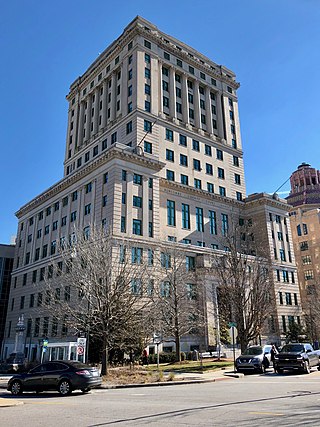
Buncombe County is a county located in the U.S. state of North Carolina. It is classified within Western North Carolina. The 2020 census reported the population was 269,452. Its county seat is Asheville. Buncombe County is part of the Asheville, NC Metropolitan Statistical Area.

Asheville is a city in, and the county seat of, Buncombe County, North Carolina, United States. Located at the confluence of the French Broad and Swannanoa rivers, it is the largest city in Western North Carolina, and the state's 11th-most-populous city. According to the 2020 census, the city's population was 94,589, up from 83,393 in the 2010 census. It is the principal city in the four-county Asheville metropolitan area, which had a population of 424,858 in 2010, and of 469,015 in 2020.

Thomas Clayton Wolfe was an American novelist of the early 20th century.

The French Broad River is a river in the U.S. states of North Carolina and Tennessee. It flows 218 miles (351 km) from near the town of Rosman in Transylvania County, North Carolina, into Tennessee, where its confluence with the Holston River at Knoxville forms the beginning of the Tennessee River. The river flows through the counties of Transylvania, Buncombe, Henderson, and Madison in North Carolina, and Cocke, Jefferson, Sevier, and Knox in Tennessee. It drains large portions of the Pisgah National Forest and the Cherokee National Forest.

North Carolina's 11th congressional district encompasses most of Western North Carolina. Since January 3, 2023, the district has been represented by Chuck Edwards.

The Asheville metropolitan area is a metropolitan area centered on the principal city of Asheville, North Carolina. The U.S. Office of Management and Budget defines the Asheville, NC Metropolitan Statistical Area, a metropolitan statistical area used by the United States Census Bureau and other entities, as comprising the four counties of Buncombe, Haywood, Henderson, and Madison. The area's population was 424,858 according to the 2010 United States Census, and 469,454 according to the 2020 United States Census.

Lillian Exum Clement, later known as Lillian Stafford, was an American politician who was the first woman elected to the North Carolina General Assembly and the first woman to serve in any state legislature in the Southern United States.

North Carolina Highway 280 (NC 280) is a primary state highway in the U.S. state of North Carolina that runs from the city of Brevard in Transylvania County to the town of Fletcher in Henderson County. It is 18 miles (29 km) in length, starting at the intersection with US 64 and US 276 north of Brevard to US 25 and US 25A in the Asheville community of Arden.

The Thomas Wolfe House, also known as the Thomas Wolfe Memorial, is a state historic site, historic house and museum located at 52 North Market Street in downtown Asheville, North Carolina. The American author Thomas Wolfe (1900–1938) lived in the home during his boyhood. The house was designated a National Historic Landmark in 1971 for its association with Wolfe. It is located in the Downtown Asheville Historic District.

OBC is the oldest known collegiate secret society operating at the University of North Carolina at Asheville. Its existence has been documented as early as May 1938.

The Valley River is a tributary of the Hiwassee River. It arises as a pair of springs in the Snowbird Mountains of Cherokee County, North Carolina and descends 2,960 feet (900 m) in elevation in approximately forty miles (64 km) to enter the Hiwassee embayment at present-day Murphy, North Carolina.

George Willis Pack was an American philanthropist, lumberman, and railroad president. Building on his father's legacy in the Lower Peninsula of Michigan, Pack successfully developed many timber businesses and became one of Michigan's first millionaires. He was also a leading citizen of Cleveland, Ohio, and a noted resident and benefactor of Asheville, North Carolina. He gave five properties to Asheville, including a school, a library, public parks, and land for the county's courthouse. In 1960, the Asheville Citizen-Times called him "Asheville's greatest benefactor."

North Carolina Highway 191 (NC 191) is a primary state highway in the U.S. state of North Carolina. It travels within portions of Henderson and Buncombe Counties.

The Bon Marché Building of Asheville, North Carolina, now the Haywood Park Hotel, was built in 1923 by E.W. Grove for the store's owner, Solomon Lipinsky. This was several years before Grove began construction on nearby Grove Arcade, one of Asheville's most famous architectural landmarks. The Bon Marché building was designed by W.L. Stoddart, a hotel architect who also designed the Battery Park Hotel and Vanderbilt Hotel.
Richard Sharp Smith was an English-born American architect, noted for his association with George W. Vanderbilt's Biltmore Estate and Asheville, North Carolina. Smith worked for some of America's important architectural firms of the late 19th century—Richard Morris Hunt, Bradford Lee Gilbert, and Reid & Reid—before establishing his practice in Asheville. His most significant body of work is in Asheville and Western North Carolina, including dozens of buildings that are listed on the National Register of Historic Places or are contributing structures to National Register Historic Districts.
Downtown Asheville Historic District is a national historic district located at Asheville, Buncombe County, North Carolina. The district encompasses about 279 contributing buildings and one contributing object in the central business district of Asheville. It includes commercial, institutional, and residential buildings in a variety of popular architectural styles including Colonial Revival, Queen Anne, and Art Deco.

Albemarle Park is an historic district in Asheville, North Carolina. Originally a mountain resort, it is now primarily a residential area of homes and apartments with retail and office spaces. Much of its significance is due to the founder, railroad magnate William Greene Raoul, and his selection of three New York City-based men to design his resort. Architect Bradford Lee Gilbert designed the core buildings, including The Manor Inn, the Lodge Gate, and several cottages. Landscape architect and author Samuel Parsons, Jr. planned the roads and romantic, naturalistic landscape. Parsons had been the head landscape architect for the city of New York after working with Frederick Law Olmsted on Central Park. A drainage and sewage plan was done by leading engineer George E. Waring Jr.
The following is a timeline of the history of the city of Asheville, North Carolina, USA.

The Vance Monument was a late 19th-century granite obelisk in Asheville, North Carolina, that memorialized Zebulon Vance, a former North Carolina governor from the area. The monument was designed by architect Richard Sharp Smith and was an "iconic landmark" and key structure in the Downtown Asheville Historic District. Smith was the supervising architect for George W. Vanderbilt's Biltmore Estate and the leading architect of the region in the late 19th and early 20th centuries. He donated his services to design the monument, which was a project envisioned by community leaders.
James Eugene Rankin was an American politician and banker. He was a leading financier in North Carolina and president of the American National Bank and the Blue Ridge Building and Loan, both in Asheville, North Carolina. The Charlotte Observer dubbed him "the dean of North Carolina's bankers".

















